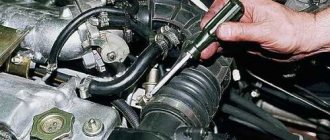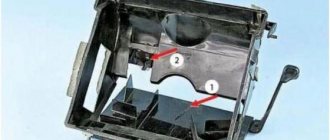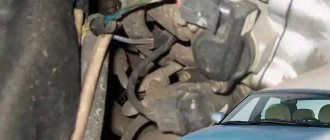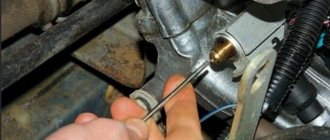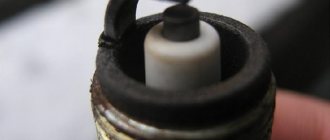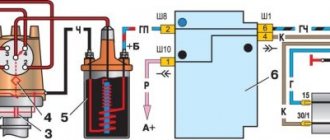Author: Alex September 28, 2021 Category: Car fault diagnosis
Often, car owners are faced with such a malfunction when, when releasing the gas, the engine speed does not drop, or more precisely, it does not drop to the normal idle level (idle). This applies to both the fuel injection system and the carburetor.
Typically, the idle speed of gasoline passenger cars, depending on the engine model, is in the range of 650-1000 rpm. Any deviations from these indicators indicate incorrect operation of the vehicle's power system. There is no point in delaying the elimination of this malfunction, since increased engine speeds lead to increased fuel consumption in the car and accelerated engine wear, which negatively affects the driver’s financial condition.
Sometimes the reason may lie in excessive enrichment of the fuel-air mixture supplied to the cylinders. This provokes an increase in speed to a certain level, after which the engine begins to “choke”, thereby reducing the speed to a normal value, after which it rises again. This malfunction causes the “floating speed” effect, but the problem may also lie in other malfunctions of the power system. In addition, do not forget that malfunctions in cases with injection and carburetor engines will be different.
How to check the XX regulator
Self-checking the serviceability of the IAC VAZ 2107 and other models consists of measuring the voltage at the connection block, checking the resistance between the sensor terminals and measuring the length of the rod.
The figure below shows a drawing of the idle air control device. I am citing it to better understand the necessary checks.
IAC connection
VAZ idle speed control device
As you can see, there are 2 windings on the sensor. This is a stepper motor, one winding of which extends the rod, the second winding retracts it. A break in these windings, a short circuit between turns or even windings indicates a malfunction.
The regulator cannot be repaired and if a malfunction is detected, it must be replaced.
To check the regulator, you need a multimeter and a caliper (or ruler).
- First you need to disconnect the block and turn on the ignition and check for voltage at terminals A and D. It should be equal to the on-board network voltage. Its absence may indicate a malfunction of the ECU or the IAC power circuit. Sometimes a resistor breaks in the ECU and no power is supplied.
- Next, switch the multimeter to resistance measurement mode and look at the resistance between windings AB and CD. It should be about 52 ohms. In other positions there should be no resistance.
- Measure the length of the extended rod, it should be 23 mm. Deviation from it also indicates a malfunction.
We recommend: Cooling system ZMZ-406: operating principle of engine cooling on Gazelle and Volga - “InfoSort”
Why does the idle speed jump on a VAZ 2107?
What to do if the idle speed of a VAZ 2107 jumps, is there any panacea for this? The fuel system causes a lot of trouble for owners, but one thing needs to be taken into account - it is not always to blame. For example, in carburetor engines with a classic ignition system, there is a high probability of contact group failure if there is instability in the idle speed. But with injection engines everything is somewhat simpler. And now about everything in more detail.
Why is the engine speed unstable?
When it comes to the carburetor, there are several reasons:
- The carburetor is clogged, the movement of air and gasoline becomes impossible.
- The operation of the solenoid valve is disrupted - the winding is burned out or the nozzle is clogged.
- Fuel or air filters are clogged.
- Incorrect carburetor adjustments on VAZ 2107.
In most cases, the culprit is the solenoid valve. Its appearance is shown in the photo. It is necessary in the power system for the following purpose - it opens the fuel supply when the ignition is turned on and closes it when it is turned off. Consequently, the engine stops immediately after turning off the ignition.
The VAZ 2107 carburetor solenoid valve is a small device consisting of the following elements:
- Frame.
- Winding (one end connected to a metal body).
- A rod that acts as a valve that opens and closes the fuel supply at idle.
- Copper jet with holes. Please note that the jets are marked; there are several sizes.
The solenoid valve operates only when the ignition is on. If suddenly there is a break in the power circuit, you can temporarily connect the central wire of the device to the positive terminal of the battery. Just try to carry out repairs as soon as possible.
Preparing to adjust the idle speed
If you do not plan to clean and disassemble the VAZ 2107 carburetor, then one of the tools you will need is a screwdriver. A device for measuring the speed (tachometer) is installed in the dashboard. But it’s worth getting a mixture quality indicator. With its help you can create an air-fuel mixture in ideal proportions. This article will talk about adjustment using this device.
Before starting work, you need to warm up the engine to operating temperature. Let us remember that this is a temperature of about 90 degrees. You also need to put the air purification filter in place to simulate normal engine operation. Make sure the float is adjusted correctly. The fuel level in the chamber must always be stable.
Carburetor speed fluctuates
You rarely see imported components on domestic cars. Basically, AvtoVAZ engines are equipped with a Solex or Ozone carburetor. Less often you can find products from the Dimitrovgrad Aggregate Plant, known for its reliability: the DAAZ carburetor. Drivers of relatively modern cars, accustomed to the check engine light, can easily determine any malfunction using an on-board computer or an inexpensive car scanner, but for veteran engine owners, only hardware diagnostics are available.
A common malfunction is idle speed floating, the main symptoms are:
- It would seem that the problem does not affect the speed - with intensive use of the gas pedal, the malfunction is invisible. However, it is dangerous in traffic jams, when the engine may suddenly stall, and when engine braking on a long descent;
- In addition, increased vibrations do not add life to the motor and attachments. Bearings of rotating shafts experience axial loads that are not typical for them. And it is uncomfortable for passengers to be in the car when the tachometer needle jumps from 500 to 1500 rpm.
The driver is forced to constantly apply gas, this distracts from the road and increases gas consumption.
So, manifestations of floating idle:
- The tachometer needle moves smoothly or sharply in the range of 1000 revolutions;
- The car shakes noticeably: there is always a feeling that it will stall;
- Pops of unburned fuel in the muffler and under the hood. In the first case, the mixture is rich, in the second, it is lean;
- Vibrations similar to tripping (at the same time you are sure that the spark plugs and the high-voltage part of the ignition system are in good condition);
- The motor randomly picks up speed, then smoothly reduces it. The problem is non-linear, it suddenly appears and also disappears suddenly (this somewhat complicates the diagnosis).
It is not difficult to localize the fault. If (we repeat: in the absence of other malfunctions), the speed fluctuates, look at the carburetor.
Why the speed fluctuates - localization of the fault
First, you need to cut off potential sources of the problem close to the carburetor.
- Let's leave the fuel supply alone. It (gasoline) is either there and the engine is running, or it is not there and there is no problem with idling (as well as the engine itself);
- A potential culprit is a clogged engine air filter. The main cause of uneven idle is air, or rather oxygen, so we inspect the first obstacle in the way of oxygen especially carefully. If you changed the filter at the end of spring, it may be clogged with June poplar fluff. Regular trips on primers, or clouds of dust donated by the “coaters”, coke the pores of the filter element within a month. It happens that a low-quality product from “homemade” ones from the Middle Kingdom simply breaks into shreds and clogs the carburetor throttle assembly with scraps. In any case, let's start by checking the filter;
- The diametrically opposite reason is excess oxygen. The intake tract of an internal combustion engine is relatively sealed. All incoming air flows are carefully calculated by engineers. In injection systems there is a mass air flow sensor, and the ECU can adjust the mixture parameters depending on the oxygen flow. The carburetor has only a mechanical setting for a certain volume. Any unauthorized air leak causes floating speed. The filter breaks, the valve cover gasket breaks, or the carburetor seal leaks - and unaccounted for (and also dirty) air goes into the chamber. The leak can be on the fittings of the vacuum tubes and on the crankcase ventilation system.
A less common cause is the housing or diaphragm of the distributor vacuum regulator. That is, the device responsible for the stable operation of the power unit is itself the cause of the malfunction.
If none of the listed reasons are found, we will inspect the carburetor. Moreover, no special equipment, much less electronic devices, is required.
Methodology for finding problems on domestic carburetor systems
Before you start troubleshooting, you need to check that the carburetor is adjusted correctly. The manufacturer sets the settings for ideal operating conditions - the amount of oxygen in the atmosphere of flat terrain and gasoline that complies with GOST. And this is on a new car.
In reality, periodic adjustment of all 4-5 carburetor adjustment screws is required. At least two of them are responsible for stable idle operation. The adjustment is made with the engine running using a simple screwdriver.
The procedure is described in the owner's manual, and differs slightly depending on the carburetor model. The main condition for correct tuning is the absence of leaks, a clean air filter, and high-quality gasoline. The amount of oxygen in the air corresponds to daily use. That is, if you live on a plain, there is no point in adjusting the carburetor while climbing a mountain serpentine to an altitude of 800 meters above sea level.
- Warm up the engine to a temperature of 90°C. If there is no thermometer, the degree of heating can be easily determined by the opening of the cooling system thermostat;
- We start the engine, give a small load - turn on the headlights and the climate system (without air conditioning). Each type of carburetor has its own idle speed, let’s take 750-800 rpm as a basis, as on Solex. The idle speed is controlled by the “quantity” and “quality” screws of the mixture. It will not be possible to establish normal speed with wine alone;
- The forced choke lever (choke) is closed;
- Using the “quality” screw, we adjust the speed to the maximum possible value. As a rule, the screw is fixed at the factory and closed with a plug. It needs to be removed;
- Next, using a standard (on the dashboard) or remote tachometer, set the speed to 900, turning only the “quantity” screw;
- Then use the “quality” screw to set the required value: 750-800 rpm.
Afterwards, you need to start the engine in normal mode, make a test drive, and accelerate in neutral several times to the maximum speed. Then turn off the engine, and after a couple of minutes start it again and check the number of revolutions at idle with a load (high beam + heater). If necessary, repeat the adjustment process.
The carburetor is adjusted, there are no other faults, but your engine speed still fluctuates
Next comes the search for real carburetor faults.
- Checking the idle speed solenoid valve. If you briefly apply power to it (by resetting and replacing the connector), you should hear a characteristic click. A faulty valve must be replaced;
- The float chamber needle valve is stuck. You will have to disassemble and wash the carburetor. If this does not help, the valve is replaced with a new one; it is impossible to sharpen or restore it at home;
- The idle passages or jets are clogged with debris. Flushing is required, preferably with the carburetor removed. A special detergent (such as “carbcleaner”) is used, then the channels are blown out with compressed air. A compressor will not work; it is better to use an inflated spare tire and a blow gun.
By and large, there are no other reasons for a floating idle associated with the carburetor. If after carrying out the above procedures, the problem remains, then this is a banal problem, with its own symptoms and causes.
The mechanical system for forming the fuel mixture requires literally surgical cleanliness of the internal components. Neglect of timely replacement of filters, as well as saving on matches (the cheapest gasoline in the area), lead to regular problems with the engine. However, eliminating them is not difficult - all you need is a simple tool and a steady hand.
Let's sum it up
First of all, a malfunction of the injection and carburetor power systems should begin to be diagnosed by inspecting the throttle valve.
In the case of an injection engine, computer diagnostics will help to accurately determine the malfunction of a specific sensor. To do this, it is best to use the services of a service that specializes in servicing cars of a specific brand.
Remember that timely diagnosis will allow you to eliminate the malfunction without significant costs.
It is very important that the engine operates correctly in any mode, including idling. However, many car owners are faced with a problem: when they release the gas, the engine speed does not drop. As soon as such a defect is discovered, it is necessary to immediately find out the cause and eliminate the malfunction for the smooth operation of the car. Also, the engine may slow down for a long time, which also does not contribute to proper operation.
Typically, upon reaching operating temperature, the speed should drop to its normal level. The manufacturer indicates the indicators for each specific vehicle model in the operating manual. They may vary slightly depending on the mileage and general condition of the car, but usually stay within the range of 650-1000 rpm.
In some cases, the speed drops very slowly or even stays at the same level of 1500-2000 revolutions. In this mode, not only does fuel consumption increase, which affects the driver’s finances, but it also contributes to engine wear.
The cause of the idle failure must be diagnosed by qualified technicians. However, you can also understand on your own why the engine speed does not drop.
Instructions for diagnosing and replacing the idle speed controller
To perform diagnostics and replace the regulator, it is enough:
- Turn off the ignition
- Stop the VAZ 2107 car with the hand (parking) brake to avoid spontaneous movement
- If the parking brake is faulty, you should use wheel chocks to secure the vehicle.
- The idle speed sensor is located on the throttle valve
- We unclip the clamp of the wire block and disconnect the block itself from the idle air control sensor
- It has terminal markings (ABCD, see photo below)
- Connect the minus volt probe of the motor
- We turn on the ignition on the car, using a voltmeter, measure the voltage at outputs A and D of the block of our idle air control
The terminals are on the ABCD block, using a voltmeter we measure the voltage at terminals A and D, the negative contact of the voltmeter is connected to engine ground
Attention: The voltage at the terminals of the idle speed sensor block should not be less than 12 Volts (“the negative” probe of the voltmeter must be connected to the “ground” of the motor). If suddenly there is no voltage or it is less than 12 Volts, it means either the battery is discharged, there may be a malfunction in the power circuit, or the ECU is faulty.
- Upon completion of the voltage measurement, turn off the ignition on the car
Other reasons
In practice, a problem can occur for many reasons, often even exotic ones that you might not immediately think of. For example, there are cases where such behavior of the motor occurred due to a generator malfunction. If it produces increased current, then the electronics begin to “go crazy”, which can be expressed, among other things, in sudden jumps in speed. If, after checking all the root causes, the source of the problem has not been identified, then check the performance of the generator.
The problem may also be in the engine ECU. If you have flashed the device, there is a possibility that it will not work correctly. Try updating the software, maybe the problem will go away.
Conclusion
. Modern cars have a large list of possible faults. Therefore, drivers may wonder why the car accelerates on its own at idle. This problem is quite common. There may be several reasons for this, both purely mechanical and related to the electronics controlling the motor.
#1 pomkka
- Users
- 22 messages
- Car make: VAZ-2107
Hello! Car VAZ 21074 injector. The problem is this: I’m driving today, I feel the car is moving painfully easily, I released the gas pedal and was surprised: it drives by itself! The BC shows instantaneous consumption of 6.0l/100km.
I decided to turn it off, put the car in neutral and the speed jumped to 4-5, I turned off the engine and it stalled only after a while (5 seconds). I try to start it and the revs jump up to 4-5 again, it starts normally only after a while.
I drive further, everything seems to be normal, but when I release the gas pedal, the car reacts only after a while, as if I had sharply braked, before in a traffic jam the speed jumped from 1 to 2 and back, the idle speed control was wrong, I replaced it, but what’s the point? zero. What could be the problem?
#2 Sashka
Don't swear at the rascal!
- VIP Member
- 4,381 messages
- Car make: was VAZ 21083i, now 21134
- From: Sredneuralsk
Post edited by Sashke: December 10, 2012 – 04:49
Problems with the carburetor system
When releasing gas, the drop in speed can be bad for both injectors and carburetor systems.
If the car has a carburetor, then there may be several defects.
Most often, the speed does not drop due to a faulty throttle valve. When the engine warms up, it is in the open position to allow more air into the system. Then it closes and the speed should drop.
If the throttle valve is not closed completely, the mixture will still be over-rich when the operating temperature is reached, and the speed will remain at the same level. If this part is heavily soiled or deformed, it cannot close completely.
You can clean the damper using a special product, which can be purchased at an automotive supply store. Deformation may require replacing the carburetor completely. The damper may not close tightly if the drive cable is severely worn. Replacing it may improve the situation.
Another common reason why the engine speed does not drop when idling is the gasket between the carburetor and the cylinder head, which has become unusable, or a damaged intake manifold.
After replacing the carburetor or cleaning the power system, you can often notice that the engine speed is slowly dropping. This occurs due to improper adjustment of the idle system; an over-enriched air-fuel mixture is often supplied. To eliminate the malfunction, it is necessary to adjust the ratio of fuel and air supply to the system.
A high level of fuel in the carburetor float chamber can also cause a malfunction. The needle valve is responsible for it. Checking this detail may correct the situation.
Checking the IAC electrical circuit.
What can you do yourself when checking the electrical circuit of the idle speed control of a VAZ 2107? Measuring the voltage at the connection block to the control unit and measuring the resistance of the regulator motor windings. To measure you need to have a tester. The diagnostic procedure is given below:
- Disconnect the block with the wiring harness from the regulator. It is located on the throttle assembly.
- Turn on the ignition.
- Set the tester to voltage measurement mode in the range from 0 to 20 volts.
- Connect the probe from the tester with a minus sign to the ground of the car.
- Connect the probe from the tester with the “plus” sign in turn to terminals “A” and “D” on the harness block. The voltage between ground and terminals should be 12 volts. If there is no voltage, the controller may not be corrected.
- Next, move the tester to the resistance measurement position. Measure the resistance of the first winding between terminals “A” and “B”. Measure the resistance of the second winding between terminals “C” and “D”. There should be 52 ohms on both windings. In other variations of measurements between the terminals, the device should indicate an open circuit. If the tester shows the opposite, then the electric motor is faulty.
IAC malfunction.
The electric motor is not the only component in the regulator that can break; there are a number of other breakdowns:
- oxidation of connector contacts, broken wires;
- contamination of the rod, preventing movement;
- the o-ring is torn;
- wear of the screw thread on the rod.
We recommend: Citroen DS continues to be the most beautiful car
Of the above breakdowns, the most common is contamination of the rod. If during operation the throttle assembly has not been maintained for a long time, carbon deposits on the regulator rod are possible. To remove dirt, you need to remove the IAC and rinse with acetone.
The stem needs to be cleaned periodically. Otherwise, the load increases, which can damage the ECU. Then you will have to contact service station specialists.
Problems in the mass air flow sensor - mass air flow sensor.
The mass air flow sensor is located in the air duct between the throttle valve and the air purification filter. It shows the volume of air entering from the atmosphere into the suction manifold. Based on these data, the control unit calculates the amount of fuel required for the current operating mode of the internal combustion engine.
If the sensor is faulty, the “Check Engine” light on the panel lights up. In parallel with this, a number of signs of failure are possible:
- Fuel consumption has increased.
- Idle speed is increased.
- The dynamics of the car are disrupted due to a decrease in power.
- It is impossible to start the internal combustion engine, even when “hot”.
- The speed changes at any throttle position, even under engine load.
Such sensors are not repaired, but replaced. Therefore, you need to make sure that this is the reason. Often the cause may be contamination of the platinum thread inside the device; it can be cleaned. Or the cause of air leakage through a damaged air duct.
Air leaks through cracks in hoses and seals.
There are many places where excess air can enter the suction manifold, bypassing the mass air flow sensor. The fuel mixture becomes leaner, the speed decreases, and the power drops. The ECU tries to correct these errors. A failure occurs in the system, the speed and “thrust” do not correspond to the specified parameters. The "Check Engine" warning light on the dashboard does not light up. The conclusion from this is that the sensors are working, but the internal combustion engine is sucking in air somewhere.
There are several places for air leaks that you should pay attention to, these are:
- the manifold with its gaskets, all kinds of joints, gaskets under the equipment attached to the manifold;
- vacuum brake booster and its hoses:
- throttle body;
- vacuum pipes.
After eliminating these shortcomings, the power unit will operate normally.
Other reasons.
A car is a complex engineering structure. During operation, its units, components, systems, and blocks are subject to wear. And it is impossible to describe all combinations of breakdowns.
Here are some reasons for the internal combustion engine not working properly:
- The ignition system has many of its own “sores”.
- Nozzles requiring professional care.
- Low quality gasoline.
- Presence of water in the fuel tank.
- Fuel and air filters are clogged.
- Other.
In each case it is necessary to understand, identify cause and effect. If you can’t do it yourself, you should contact a service station specialist.
In this article, “Why do idle speeds fluctuate on a VAZ 2107 injection engine,” the emphasis is on the breakdown of the XX Regulator. If it is broken, it can hardly be repaired. It's better to change it. It’s not difficult to do it yourself, having a new IAC and a minimum of tools.


